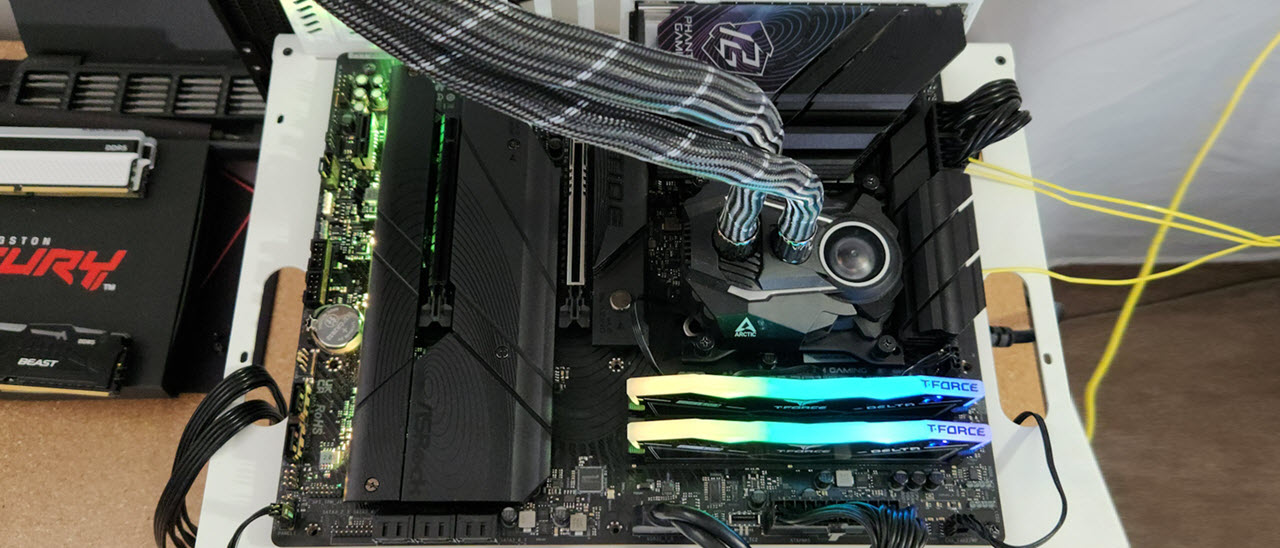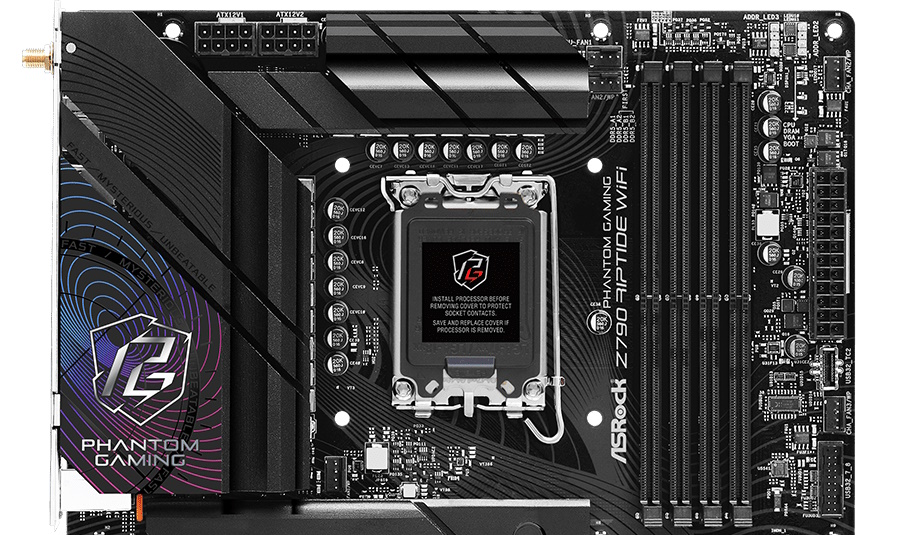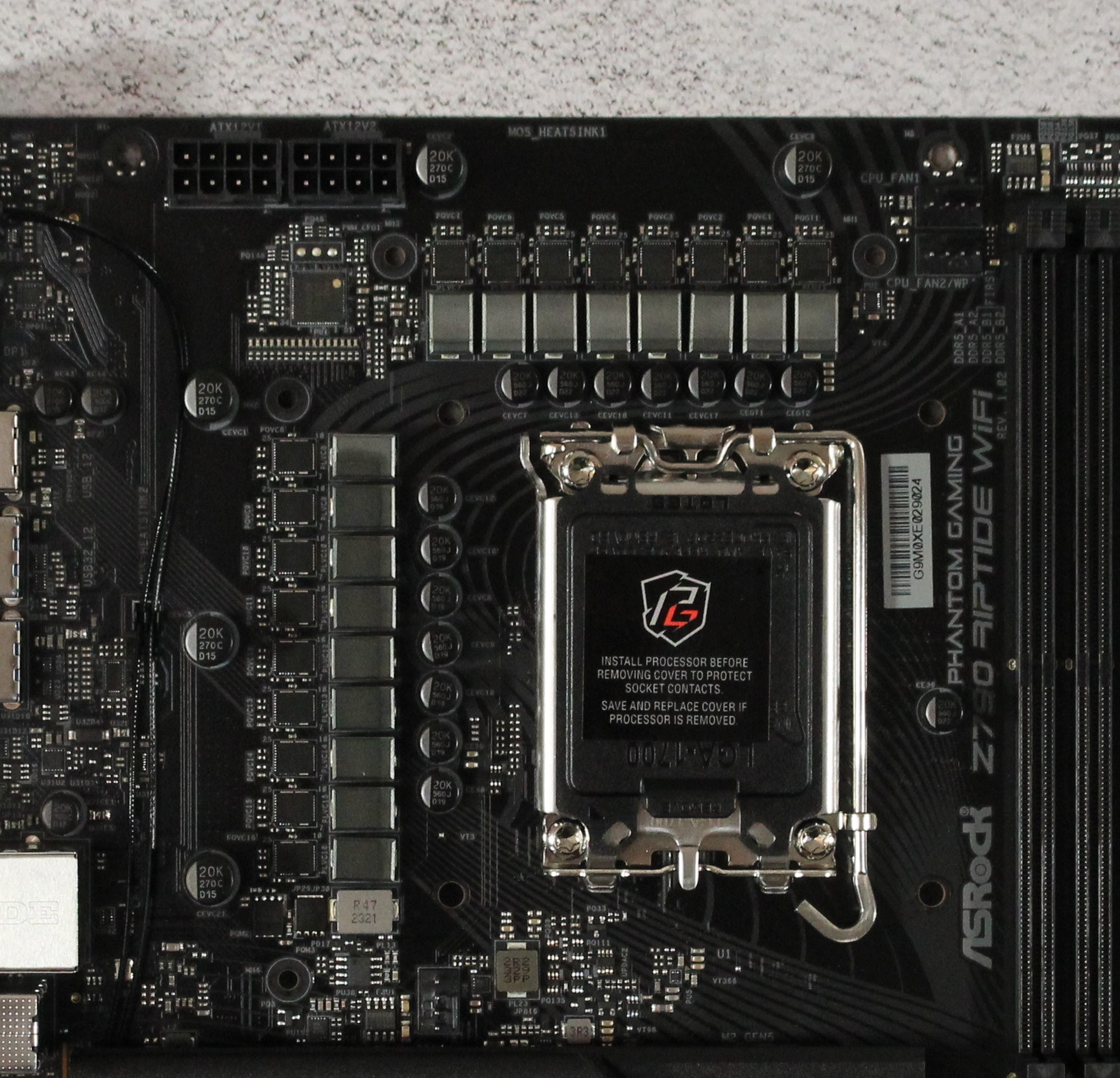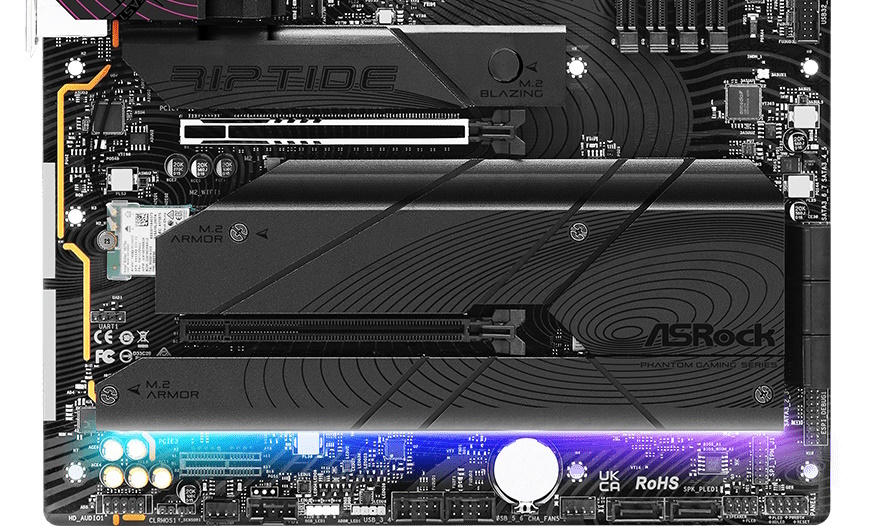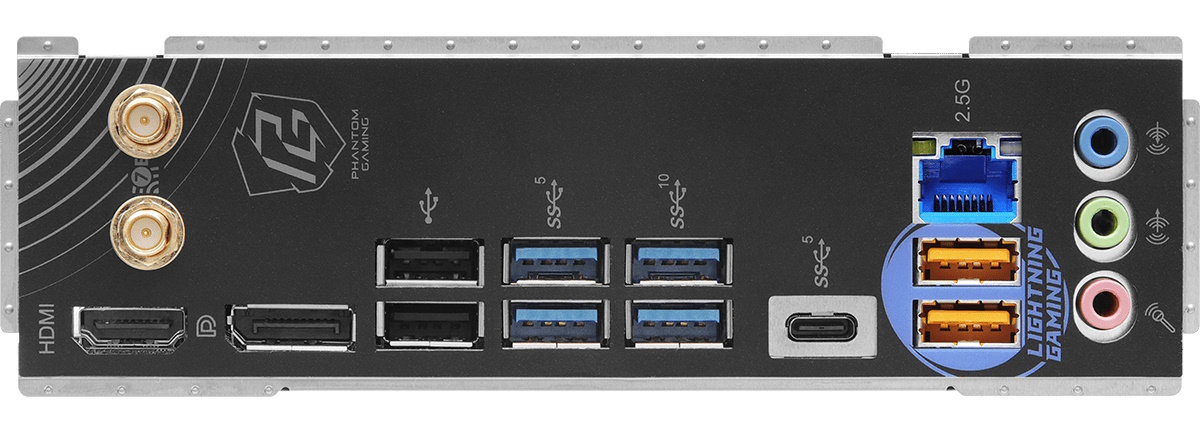Tom's Hardware Verdict
The Z790 Riptide is one of the most handsomely equipped motherboards around $230. In addition to the copious storage options (five M.2 sockets and eight SATA ports), it was competent in all benchmarks and looks good, especially if you like RGB lightning.
Pros
- +
Plethora of storage options (8x SATA, 5x M.2)
- +
Includes PCIe 5.0 x4 M.2 socket
- +
eDisplayPort
- +
Well priced
Cons
- -
Slower USB speeds on the Rear IO
Why you can trust Tom's Hardware
The latest board to land on our test bed from ASRock is the budget-oriented Phantom Gaming Z790 Riptide. Priced at $229 at the time of publication, it offers users a well-rounded solution at a price most bank accounts can handle. For the money, you get a predominantly black design that fits in with most build themes, with a bright RGB strip along the bottom M.2 socket. Hardware-wise, ASRock continues its trend of value for your dollar, including a PCIe 5.0-capable M.2 socket and integrated Wi-Fi 7, where others may not. In all, it’s a well-equipped and inexpensive Z790 motherboard.
You’ll be hard-pressed to find something better equipped for this price. Most Z790 boards around the $230-plus price point lack a PCIe 5.0-capable M.2, Wi-Fi 7, and at least some storage options. The Raptor Lake refresh boards by the other major board partners tend to be more expensive, with the only major difference being Wi-Fi 7 (and native 14th-gen support). Otherwise, their specs remain the same. Additionally, you get a quality last-gen audio codec, Killer-based 2.5 GbE, and, when setting the cooler to 360/420 AIO, a BIOS that lets your cooling be the limiting factor of performance. As you’ll see later, our board performed well in our testing, especially in the Procyon Office benchmarks.
Below, we’ll dig into the details of the board and see how it performed across all of the tests against a few other new Z790 motherboards. It has an excellent chance to make our best motherboard list for budget boards and is worth a look at versus more expensive options in the mid-range segment, considering the specs. Before we get into those details, we’ll start by listing the specifications from the ASRock website.
Specifications: ASRock PG Z790 Riptide
| Socket | LGA1700 |
| Chipset | Z790 |
| Form Factor | ATX |
| Voltage Regulator | 18 Phase (16x 90A SPS MOSFETs for Vcore) |
| Video Ports | (1) DisplayPort (v1.4) |
| Row 5 - Cell 0 | (1) eDisplayPort (v1.4) |
| Row 6 - Cell 0 | (2) HDMI (v2.1) |
| USB Ports | (1) USB 3.2 Gen 1 Type-C (5 Gbps) |
| Row 8 - Cell 0 | (2) USB 3.2 Gen 2 (10 Gbps) |
| Row 9 - Cell 0 | (4) USB 3.2 Gen 1 (5 Gbps) |
| Row 10 - Cell 0 | (2) USB 2.0 (480 Mbps) |
| Network Jacks | (1) 2.5 GbE |
| Audio Jacks | (3) Analog |
| Legacy Ports/Jacks | ✗ |
| Other Ports/Jack | ✗ |
| PCIe x16 | (1) v5.0 x16 |
| Row 16 - Cell 0 | (1) v4.0 x4 |
| PCIe x8 | ✗ |
| PCIe x4 | ✗ |
| PCIe x1 | (1) v3.0 x1 |
| CrossFire/SLI | Supports AMD Crossfire |
| DIMM Slots | (4) DDR5 8000+(OC), 192GB Capacity |
| M.2 Sockets | (1) PCIe 5.0 x4 (128 Gbps) / PCIe (up to 80mm) |
| Row 23 - Cell 0 | (4) PCIe 4.0 x4 (64 Gbps) / PCIe (up to 80mm) |
| Row 24 - Cell 0 | Supports RAID 0/1/5/10 |
| SATA Ports | (8) SATA3 6 Gbps (Supports RAID 0/1/5/10) |
| USB Headers | (1) USB v3.2 Gen 2x2, Type-C (20 Gbps) |
| Row 27 - Cell 0 | (1) USB v3.2 Gen 1 (5 Gbps) |
| Row 28 - Cell 0 | (2) USB v2.0 (480 Mbps) |
| Fan/Pump Headers | (7) 4-Pin (CPU, CPU/waterpump, Chassis fans) |
| RGB Headers | (3) aRGB (3-pin) |
| Row 31 - Cell 0 | (1) RGB (4-pin) |
| Diagnostics Panel | (1) Post Status Checker (4 LEDs) |
| Internal Button/Switch | ✗ |
| SATA Controllers | ✗ |
| Ethernet Controller(s) | (1) Killer E3100G (2.5 GbE) |
| Wi-Fi / Bluetooth | Wi-Fi 7 (2x2 be, MU-MIMO, 320 MHz, BT 5.4) |
| USB Controllers | ASMedia 1074 |
| HD Audio Codec | Realtek ALC1220 |
| DDL/DTS | ✗ / ✗ |
| Warranty | 3 Years |
Inside the Box of the ASRock PG Z790 Riptide
Inside the box is a sparse set of accessories to help get your PC up and running without an extra trip to the store. You get SATA cables, a Wi-Fi antenna, a manual, a thermistor cable, and an ARGB splitter cable. You’ll need to find the drivers on the ASRock website, as a disk or USB stick isn’t included.
Design of the Z790 Riptide
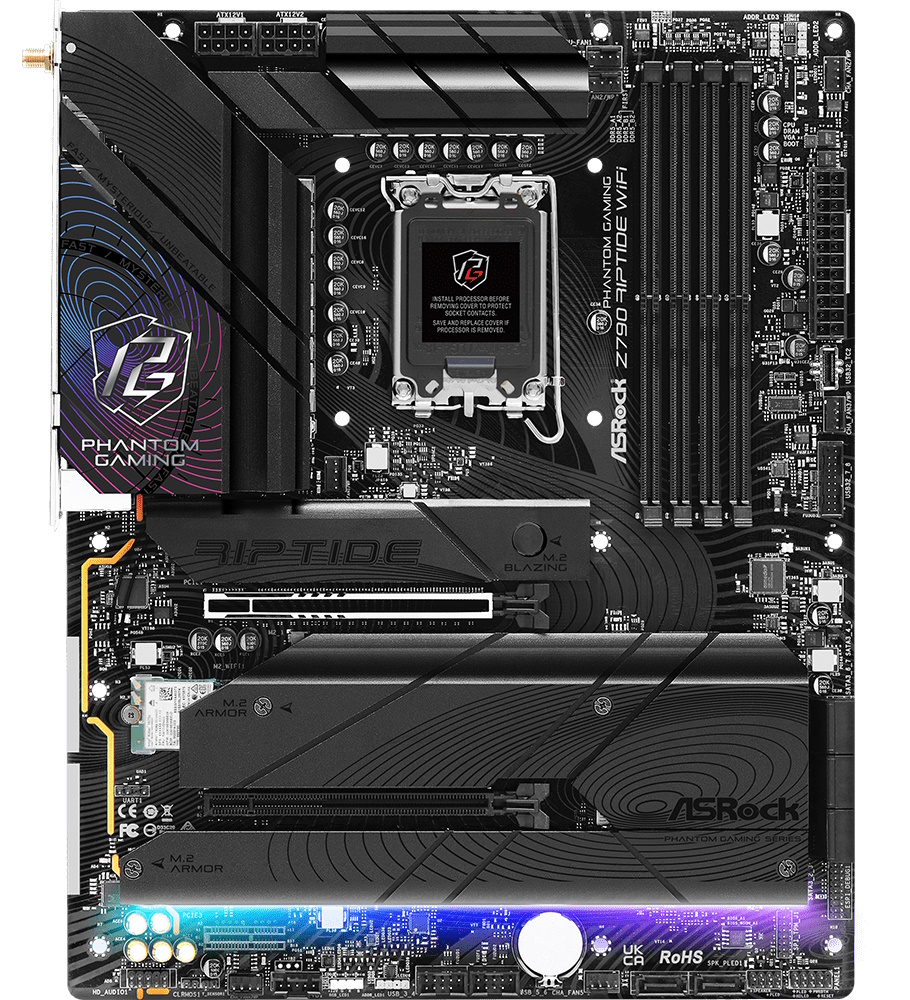
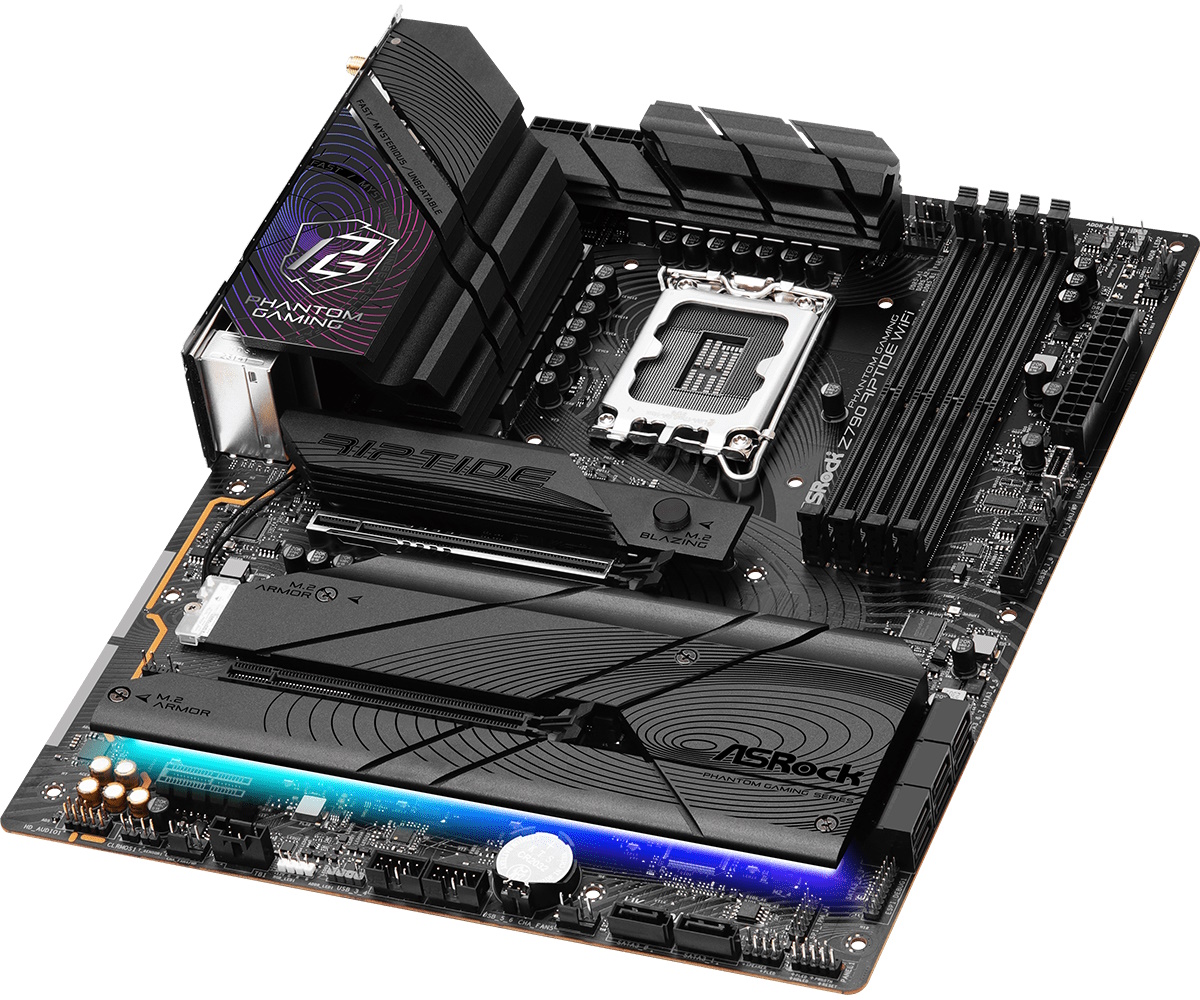
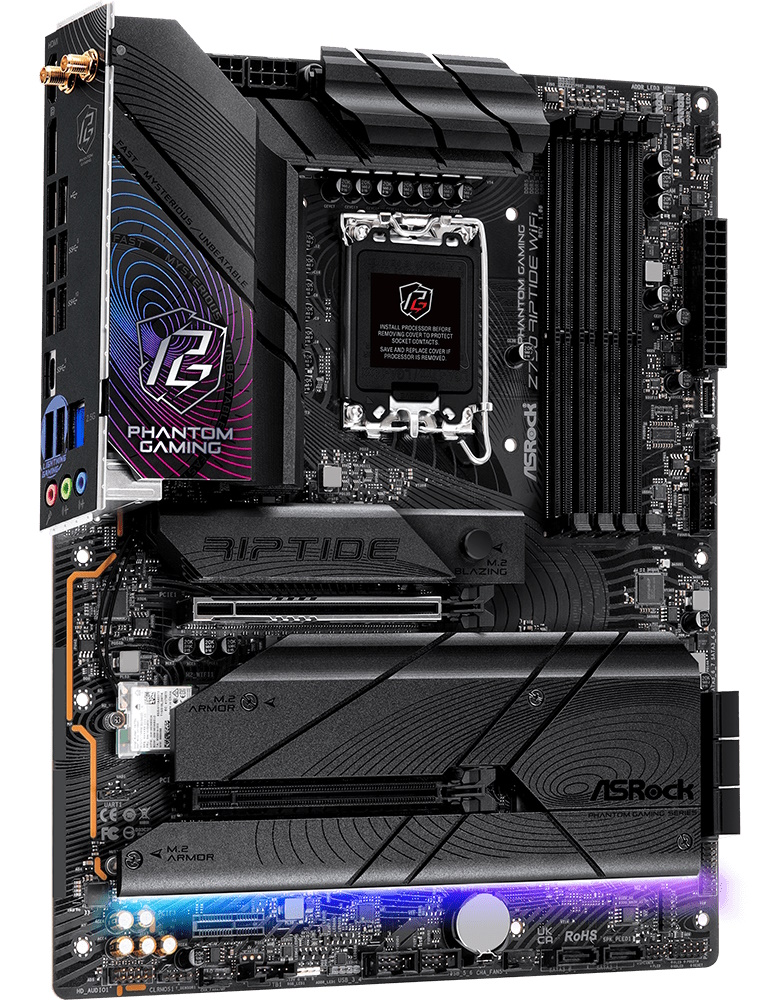
The Z790 Riptide echoes the other Phantom Gaming (PG) boards, working with an all-black look and a wavy pattern on the 8-layer PCB. Breaking up the monotony is the PG symbol on the left VRM heatsink, along with a circular blue-to-purple pattern. The heatsink reaches out over the rear IO bits, which makes for a clean look. The bottom portion of the board has multiple heatsinks covering all five M.2 sockets, and that same wavy pattern is visible, but in black. The top heatsink for the PCIe 5.0 socket uses a quick-release function - a nice value add.
Across the entire length of the bottom M.2 heatsink is a bright RGB LED strip that will illuminate the inside of your chassis. The colors are saturated, and by default, they are bright! Using ASRock's Polychrome application, you can adjust and control the integrated and any attached RGB devices. For a budget motherboard, it looks good, and you won’t mind showing it off inside the case. That said, if the Wi-Fi adapter were covered, it would clean up the look a bit.
Our board tour starts in the upper left corner, where we spy dual 8-pin EPS connectors (one required) to power the CPU. Below it are two heatsinks to cool the VRM. They are large and have enough surface area to keep the high-quality VRM below within specification.
Get Tom's Hardware's best news and in-depth reviews, straight to your inbox.
In the socket area and just above the M.2 socket are the first (of six) 4-pin fan headers. Each header supports PWM and DC-controlled devices. CPU_FAN2/WP and CHA_FAN1-4 auto-detect if a 3-pin or 4-pin device is in use. For the others, you’ll have to set it manually. CPU_FAN2/WP and CHA_FAN1-4 output up to 2A/24 each, while the others are at 1a/12W. There are plenty of headers and enough power to go around.
Continuing right past the socket, we find four unreinforced DRAM slots with locking mechanisms on the top and bottom. ASRock lists support up to 192GB, accepting those 24/48GB kits with speeds up to DDR5-8000+(OC). Our base DDR5-6000 kit and the DDR5-7200 kit worked, but the DDR5-8000 kit did not want to play nice. It wasn’t on the Memory QVL list, though several other SKUs are.
Along the right edge, we fund another 4-pin fan header and a 4-LED Post Status Checker behind it. Unlike other boards with this tool, the Z790 Riptide uses four red LEDs, whereas others use unique colors. It’s also not labeled, so you’d have to look at the manual to determine which LED corresponds to what problem (CPU, Boot, DRAM, VGA). Next is the 24-pin ATX connector to power the board, the front panel USB 3.2 Gen 2x2 (20 Gbps) header, another 4-pin fan header, and finally, a 19-pin front panel USB 3.2 Gen 1 (5 Gbps) header for additional front USB connectivity.
The Power delivery of the Z790 Riptide consists of 18 phases in total, with 16 dedicated to the processor. Power heads from the 8-pin EPS connectors to a Renesas RAA229131 controller. It moves on to 16 90A Intersil ISL99390 SPS MOSFETs. This is one of the more robust VRMs in the $230 price range. The 1,440A available is more than enough to handle the flagship Intel i9-14900K, even overclocked.
On the bottom of the board, the left side hosts the audio solution. In this case, you can see a Realtek ALC1220 codec fully exposed and several yellow capacitors dedicated to audio. Most users will find the last-gen flagship perfectly acceptable, as you’ll rarely see the newer codec at this price.
In the middle of the board are three PCIe slots and FIVE M.2 sockets. Starting with the storage, all five sockets handle up to 80mm modules, with four running up to PCIe 4.0 x4 (64 Gbps) speeds, and one (the top socket) is a PCIe 5.0 x4 (128 Gbps) socket. Note that when the M.2_Gen5 (top socket) gets occupied, PCIE1 downgrades to x8 mode. I’d like to see a more significant heatsink on the PCIe 5.0 socket; otherwise, the configuration is fine. We jump over the chipset heatsink to the right edge and find six of the eight SATA ports. If you’d like to RAID your NVMe or SATA drives, both support RAID 0/1/5/10 modes. There are plenty of storage options between the five M.2 sockets and eight SATA ports.
Mixed in around the M.2 sockets are two full-length PCIe slots and one PCIe x1 slot. The top slot connects through the CPU and runs up to the full PCIe 5.0 x16 bandwidth. The middle slot connects through the chipset and runs up to PCIe 4.0 x4. Last, the open-ended (accepts larger than x1-size attachments) PCIe x1 slot connects through the CPU and runs PCIe 3.0 x1 speeds. If you want to try your luck at multi-GPU, the Riptide supports AMD Crossfire.
Across the bottom of the board are several exposed vertical headers. Here, you’ll find additional USB, system fan headers, SATA ports, and more. Below is a complete list from left to right.
- Front panel audio
- Clear CMOS jumper
- 2-pin Thermal sensor header
- Chassis fan header
- 5-pin Thunberbolt AIC header
- 4-pin and 3-pin RGB headers
- (2) USB 2.0 headers
- Chassis fan header
- (2) SATA ports (vertical)
- Front panel
The rear IO panel matches the black PG theme and, along with light gray labels, makes the ports easy to read. The Wi-Fi 7 antenna connections are on the left, plus HDMI and DisplayPort below. Next are six USB ports: two USB 2.0 (480 Mbps), five USB 3.2 Gen1 (5 Gbps) including a Type-C, and two USB 3.2 Gen 2 (10 Gbps) that are also the Lightning USB ports. Above them is the Killer E3100 2.5 GbE port. And last, on the right edge, is a 3-plug audio stack.
One other feature worth pointing out is the eDP connector on the back of the board. With this, users can connect an additional display, such as ASRock’s 13.3-inch Side Panel Kit. The IPS panel supports up to 1920x1080 resolution at 60 Hz and helps display system information or almost anything you like.
MORE: Best Motherboards
MORE: How To Choose A Motherboard
MORE: All Motherboard Content

Joe Shields is a staff writer at Tom’s Hardware. He reviews motherboards and PC components.
-
Gururu I got a little confused because there are two boards, one is WiFi and the other is not. This appears to be the Wifi Version.Reply
non-wifiwifi -
thestryker If PCIe 5.0 M.2 is going to be listed as a pro on Z790 it also needs to be in con for cutting the primary slot to x8 when in use. Like most boards it also doesn't actually add a M.2 to the board either because it's one or the other situation between M2_1 and M2_5 so it doesn't actually have 5 M.2 slots it has 4.Reply -
xyriin Recently purchased this board for my upgrade to a 14700K. The hardware is great and a better value than similar offerings.Reply
The flaw? ASRock's RGB software is hot garbage.
How bad? When the software locks up while you are changing lighting settings it corrupts the firmware. For a fix you have to flash firmware and reboot. I haven't been able to run the software longer than 5 minutes without a crash. -
Hrdwr Reply
Not really, that's mostly the case which cheaper boards where pcie 5.0 and pcie 4.0 m.2 slots overlap physically or all m.2 ports except one are connected to chipset. Here you can really use all 5 simultaneously (first 2 are connected to the cpu and other 3 to chipset) and this is cheapest such board you can find. Asrock Nova is probably only one where you can have 6. Keep in mind that having 2 or more on the chipset can bottleneck chipset connection that has only 8 DMI lanes, but using so many drives at once is rare case scenario and people needing more high speed connectivity should opt for lower tier AMD based HEDT. Nevertheless, prior to this you would need 4 m.2 slot PCIE card for this purpose that would cost you at least 100$ and be worse at cooling those drives. As there's less available 4TB nvme and 8TB are expensive and there's no use using SATA SSD at these prices many people will find use of this. As for the x8 GPU penalty it's only 5% for fastest GPUs so a none issue for most people anyway... There's always some compromising to do and all these features are fantastic storage leap compared to ones we had just few years ago....thestryker said:If PCIe 5.0 M.2 is going to be listed as a pro on Z790 it also needs to be in con for cutting the primary slot to x8 when in use. Like most boards it also doesn't actually add a M.2 to the board either because it's one or the other situation between M2_1 and M2_5 so it doesn't actually have 5 M.2 slots it has 4. -
xyriin Reply
You are correct that there are five independent M.2 slots that can be used at the same time. However, even the Asrock Nova board is limited to x8 mode on PCIE1 when the PCIe Gen5 M.2 slot is in use. Even ultra high-end boards like the Asus ROG Formula/Dark Hero that have two PCIE Gen5 PCIE slots; disable PCIE2 and degrade PCIE1 to x8 when using the PCIe Gen5 M.2 slot.Hrdwr said:Not really, that's mostly the case which cheaper boards where pcie 5.0 and pcie 4.0 m.2 slots overlap physically or all m.2 ports except one are connected to chipset. Here you can really use all 5 simultaneously (first 2 are connected to the cpu and other 3 to chipset) and this is cheapest such board you can find. Asrock Nova is probably only one where you can have 6. Keep in mind that having 2 or more on the chipset can bottleneck chipset connection that has only 8 DMI lanes, but using so many drives at once is rare case scenario and people needing more high speed connectivity should opt for lower tier AMD based HEDT. Nevertheless, prior to this you would need 4 m.2 slot PCIE card for this purpose that would cost you at least 100$ and be worse at cooling those drives. As there's less available 4TB nvme and 8TB are expensive and there's no use using SATA SSD at these prices many people will find use of this. As for the x8 GPU penalty it's only 5% for fastest GPUs so a none issue for most people anyway... There's always some compromising to do and all these features are fantastic storage leap compared to ones we had just few years ago....
In my opinion, we just aren't there yet for PCIe Gen 5 drives. Until CPUs and chipsets can support 16x16 it doesn't make a whole lot of sense and the cooling concern is still a factor. -
35below0 Reply
I agree about asking too much from a cheaper board, but the objection about downgrading the main PCIe x16 slot stands. There are practically no other features that conflict with each other or cancel each other out, or are limited and disclaimed with *** (RAM being the most obvious exception). the PCIE1 and M.2_A are kind of important and not being able to have both almost defeats the purpose of "blazing" 5.0 NVMesHrdwr said:Not really, that's mostly the case which cheaper boards where pcie 5.0 and pcie 4.0 m.2 slots overlap physically or all m.2 ports except one are connected to chipset. Here you can really use all 5 simultaneously (first 2 are connected to the cpu and other 3 to chipset) and this is cheapest such board you can find. Asrock Nova is probably only one where you can have 6. Keep in mind that having 2 or more on the chipset can bottleneck chipset connection that has only 8 DMI lanes, but using so many drives at once is rare case scenario and people needing more high speed connectivity should opt for lower tier AMD based HEDT. Nevertheless, prior to this you would need 4 m.2 slot PCIE card for this purpose that would cost you at least 100$ and be worse at cooling those drives. As there's less available 4TB nvme and 8TB are expensive and there's no use using SATA SSD at these prices many people will find use of this. As for the x8 GPU penalty it's only 5% for fastest GPUs so a none issue for most people anyway... There's always some compromising to do and all these features are fantastic storage leap compared to ones we had just few years ago....
I wouldn't so off-handedly dismiss the 8x downgrade.
On the other hand, this board costs less and offers plenty of M.2 slots. So the non-gamer and gamer can both have their cake with the same board. Just not both cakes. -
thestryker Reply
So about that in the manual it quite literally says the following:Hrdwr said:Not really, that's mostly the case which cheaper boards where pcie 5.0 and pcie 4.0 m.2 slots overlap physically or all m.2 ports except one are connected to chipset. Here you can really use all 5 simultaneously (first 2 are connected to the cpu and other 3 to chipset) and this is cheapest such board you can find.
Either M2_1 or M2_5 can be used at a time.
They literally occupy the same area on the motherboard with alternating socket sides. Even if it did work you're not going to stack a PCIe 4.0 and 5.0 drive.
Adding a PCIe 5.0 M.2 is not necessary for having a ton of M.2 connectivity. It's a tradeoff (until Intel adds dedicated lanes which they are) for very minimal returns to check a box. You can get the same thing by wiring up two PCIe slots to PCIe 5.0, but give your customers more flexibility in the process. Nobody should be happy with making their primary slot x8 and only being able to use x4 of the remnant.Hrdwr said:Asrock Nova is probably only one where you can have 6. Keep in mind that having 2 or more on the chipset can bottleneck chipset connection that has only 8 DMI lanes, but using so many drives at once is rare case scenario and people needing more high speed connectivity should opt for lower tier AMD based HEDT. Nevertheless, prior to this you would need 4 m.2 slot PCIE card for this purpose that would cost you at least 100$ and be worse at cooling those drives. As there's less available 4TB nvme and 8TB are expensive and there's no use using SATA SSD at these prices many people will find use of this. As for the x8 GPU penalty it's only 5% for fastest GPUs so a none issue for most people anyway... There's always some compromising to do and all these features are fantastic storage leap compared to ones we had just few years ago.... -
xyriin Reply
You may be thinking about another motherboard model. The PG Riptide has five physically discrete M.2 slots that do not overlap. You can see this on page 7 of the manual. In addition, the following warnings about the dedicated M.2 Gen 5 slot are as follows:thestryker said:So about that in the manual it quite literally says the following:
They literally occupy the same area on the motherboard with alternating socket sides. Even if it did work you're not going to stack a PCIe 4.0 and 5.0 drive.
Adding a PCIe 5.0 M.2 is not necessary for having a ton of M.2 connectivity. It's a tradeoff (until Intel adds dedicated lanes which they are) for very minimal returns to check a box. You can get the same thing by wiring up two PCIe slots to PCIe 5.0, but give your customers more flexibility in the process. Nobody should be happy with making their primary slot x8 and only being able to use x4 of the remnant.
Page 2 - If M.2_GEN5 is occupied, PCIE1 will downgrade to x8 mode.
Page 4 - If M.2_GEN5 is occupied, PCIE1 will downgrade to x8 mode.
Page 25 - If M.2_GEN5 is occupied, PCIE1 will downgrade to x8 mode.
Page 44 - If M.2_GEN5 is occupied, PCIE1 will downgrade to x8 mode.
Page 47-52 - Cover installation of M2_1-4 and no warnings related to M2_GEN5
Page 12 - You can see the lane assignments where the M2_GEN5 slot shares ONLY with PCIE1
Further, the manual never refers to any M.2 slot as M2_5; only M2_1, M2_2, M2_3, M2_4 and M2_GEN5. You are of course free to correct any errors by referencing the appropriate page number in the manual.
But going back to your original statement. Your first sentence is correct in that using M2_GEN5 will drop PCIE1 to x8. However, your second sentence is incorrect because the PG Riptide can use five M2 drives at the same time. -
thestryker Reply
Yup there are apparently two different PG Z790 Riptide boards and this review misnames the one being reviewed (WIFI is part of the name). I should have looked for the matching wifi spec, but yeah splitting the lanes off is still dumb.xyriin said:You may be thinking about another motherboard model. -
Hrdwr Reply
I stand corrected, I thought the article is about riptide wifi, not regular riptide. That one actually has 5 independent m.2 slots and all can be used at the same time, but pcie 5.0 slot still gets downgraded. It also has heatsinks for all the drives, tad better VMRs and support for up to 8000 mhz memory, but does cost more...thestryker said:So about that in the manual it quite literally says the following:
They literally occupy the same area on the motherboard with alternating socket sides. Even if it did work you're not going to stack a PCIe 4.0 and 5.0 drive.
